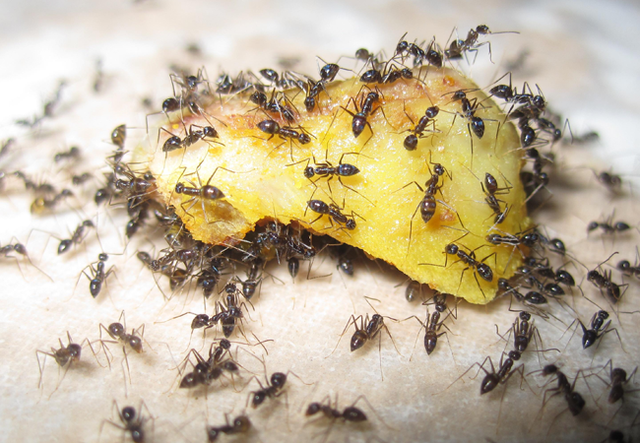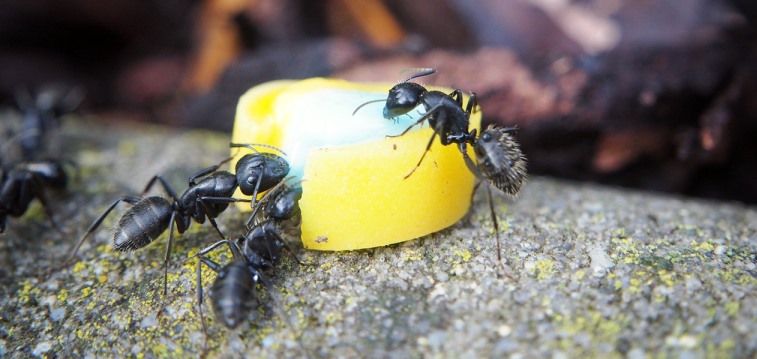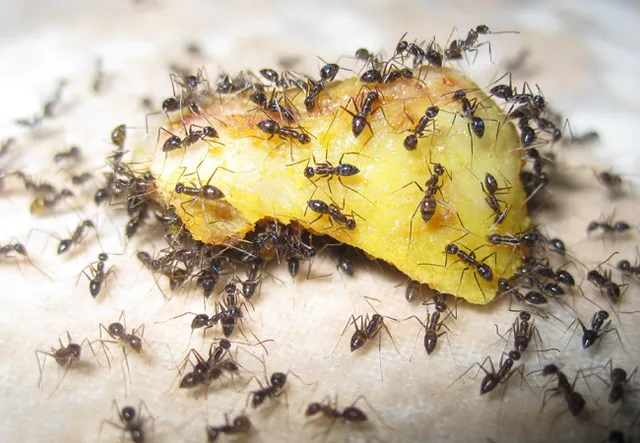Ants eat daily to survive and function properly. They require a constant supply of food to sustain their energy levels and nourish their colonies.
Ants have a diverse diet, consuming a wide range of organic matter including other insects, nectar, seeds, and even sugary substances. Their eating habits are regulated by their metabolic needs and the availability of food in their environment. Ants are diligent foragers, constantly seeking out new food sources and storing them within their nests for future consumption.
Understanding the feeding patterns of ants is vital for effective pest control and managing their impact on ecosystems. By comprehending how often ants eat, it is possible to develop strategies to mitigate their impact on crops, infrastructure, and human living spaces.

Credit: www.ecoguardpestmanagement.com
Ants’ Feeding Habits
Ants are fascinating creatures with a unique feeding behavior that plays a vital role in their colonies’ survival.
Frequency Of Ant Feeding
- Ants feed multiple times a day to sustain their energy levels.
- They have frequent feeding cycles to meet the colony’s nutritional needs.
Amount Of Food Consumed
- Ants consume small quantities of food at a time to share among the colony.
- They store excess food in their nests for times of scarcity.
Factors Influencing Ant Feeding
Understanding the factors that influence ant feeding behaviors is crucial for effective pest management. From food availability to seasonal variations, several elements play a role in when and how often ants feed.
Food Availability
Food availability plays a significant role in determining the feeding patterns of ants. Ants will feed more frequently when there is a abundant supply of food sources accessible to them. They tend to become more active and search for food when resources are scarce, leading to increased feeding frequency. Additionally, the types of food available can impact their feeding habits. For instance, high-sugar or protein-rich food sources can trigger frequent feeding behavior as ants satisfy the nutritional needs of the colony.
Colony Needs
Colony needs also heavily influence ant feeding frequency. Ants usually prioritize the wellbeing of their colony, which directly impacts their foraging and feeding patterns. When the colony requires more sustenance, ants will intensify their feeding activities, often leading to more frequent and extensive foraging expeditions to meet the needs of the entire group.
Seasonal Variation
Seasonal variation plays a pivotal role in ant feeding behaviors. With shifts in environmental conditions, such as temperature and precipitation, the availability of food sources fluctuates, leading to varying feeding patterns. During warm months, ants may exhibit more frequent feeding behaviors due to increased food availability, while in colder seasons, their feeding frequency may reduce as food sources become scarcer.
Ants’ Dietary Preferences
Ants’ dietary preferences play a crucial role in their survival and behavior. Understanding the feeding habits of ants is essential in pest control and ecosystem management. Let’s delve into the dietary preferences of ants and explore how their feeding habits impact their behavior and ecology.
Omnivorous Diet
Ants are omnivorous creatures, meaning they consume a wide variety of foods including plant matter, other insects, and even sugary substances. Their adaptable diet allows them to thrive in diverse environments, from forests to urban areas.
Preferred Foods
Ants prioritize different types of food based on their species and the needs of their colony. While some ants favor plant-based materials such as nectar and seeds, others prefer protein sources like other insects and even carrion. Understanding an ant species’ preferred foods can be instrumental in managing infestations and conserving native ecosystems.
Ants As Scavengers
As scavengers, ants play a crucial role in nutrient cycling and waste decomposition. They scavenge on dead organisms and organic matter, contributing to the breakdown of decaying material in their environment. This behavior is particularly vital in maintaining the balance of ecosystems and preventing the accumulation of organic waste.
Foraging Behavior Of Ants
Ants are diligent creatures when it comes to finding food, a behavior known as foraging. Let’s delve into the fascinating world of Foraging Behavior of Ants.
Exploration And Trail Marking
Ants explore their surroundings methodically, leaving chemical trails called pheromones to guide them back to food sources.
Communal Foraging
Ants work together in groups to gather food efficiently, pooling resources and sharing information about food locations.
Division Of Labor In Foraging
Ant colonies divide the tasks of foraging among different castes, ensuring efficient resource gathering for the entire colony.
Ants As Farmers
Ants are known to be farmers, and they eat several times a day to sustain their work on the farm. These creatures feed on a variety of foods, including sugary liquids, proteins, and fats, displaying a diverse diet to fuel their activity.
Ants are not just industrious creatures that scavenge for food – some species of ants have taken farming to a whole new level. These fascinating insects have evolved complex systems where they cultivate crops and harvest them for sustenance. In this section, we will explore two types of ants that have mastered the art of farming – Fungus-Farming Ants and Leaf-Cutter Ants.Fungus-farming Ants
One group of ants, known as Fungus-Farming Ants, have been tending to their fungal gardens for millions of years. These ants rely on a mutualistic relationship with a specific type of fungus that they cultivate. The ants meticulously maintain their gardens by providing a nurturing environment for the fungus to grow. They forage for plant debris, which they chew and mix with their own feces to create a substrate where the fungus thrives. Once the fungus blooms, the ants diligently prune and weed their gardens to eliminate any competing fungi or molds.The harvested fungus serves as the primary food source for the ant colony. It provides the necessary nutrients and sustenance for the ants, ensuring their survival and growth. Studies have shown that the ants even have specific chambers within their nests that are dedicated to housing their fungal gardens. This showcases the intricate nature of their farming practices.Leaf-cutter Ants
Another remarkable example of ants as farmers is the Leaf-Cutter Ants. These industrious ants are best known for their exceptional leaf-cutting abilities. They scavenge trees and vegetation, selectively choosing leaves to cut and carry back to their colony. However, the purpose of their leaf collecting is not for direct consumption but rather for cultivating a special type of fungus.The leaf fragments provide the necessary substrate upon which the ants grow their fungal gardens. As the ants bring back the leaves, they chew them into a pulp-like consistency and inoculate them with a specific fungus. This fungus becomes the food source for the ant colony. The ants tend to their gardens, controlling temperature and humidity levels to promote optimal fungal growth.The farming practices of Leaf-Cutter Ants are so efficient and productive that their colonies can sustain millions of ants. The leaf fragments act as a constant source of nutrition, allowing these ants to thrive and flourish.In conclusion, ants demonstrate remarkable agricultural practices as they have evolved into skilled farmers. Fungus-Farming Ants and Leaf-Cutter Ants are just two examples of ants that have mastered the art of cultivating crops. Their sophisticated farming methods serve as a testament to the ingenuity and adaptability of these tiny insects.
Credit: ant-pests.extension.org
Ants’ Relationship With Honeydew
Ants feed on honeydew produced by aphids, their primary food source. They consume honeydew as often as the aphids excrete it, forming a symbiotic relationship. This constant food supply fuels the ants’ colony and helps protect the aphids from predators.
Feeding On Plant Sugars
Ants have a fascinating relationship with honeydew, a sweet, sticky liquid produced by plant-sucking insects such as aphids, mealybugs, and scale insects. These small insects feast on the sap of plants, extracting the essential sugars they need to survive. However, their feeding habits inadvertently create a valuable food source for ants.
When these insects consume plant sap, they excrete excess sugars in the form of honeydew. This sugary substance is highly attractive to ants, who readily feed on it. In fact, ants have developed sophisticated mechanisms to retrieve honeydew from plant-sucking insects. They use their antennae to stroke the insects’ abdomens, stimulating the release of honeydew droplets.
Ants have even been observed fiercely defending their honeydew-producing partners from predators, such as ladybugs and parasitic wasps. In return for this protection, the plant-sucking insects allow ants to freely access their honeydew supply.
Symbiotic Relationships With Insects
This relationship between ants and honeydew-producing insects is an example of a mutualistic symbiotic relationship. In mutualism, both species benefit from the association. The ants gain a valuable food source, while the honeydew-producing insects enjoy protection from predators.
Ants have evolved unique adaptations to facilitate this mutually beneficial relationship. They construct intricate “ant highways” or trails leading to honeydew sources, allowing large numbers of ants to efficiently collect and transport the precious liquid back to their colonies. This process ensures a steady supply of nourishment for the ant colony.
Interestingly, some species of ants have even developed a mutually beneficial relationship with specific honeydew-producing insects. These ants actively cultivate and care for these insects, moving them to optimal feeding locations and protecting them from harm. In return, the ants receive a constant supply of honeydew, which becomes an essential part of their diet.
Feeding Adaptations Of Ants
Feeding Adaptations of Ants: Ants have fascinating feeding adaptations that contribute to their success as a species.
Mandibles And Jaw Strength
Ants have powerful mandibles that enable them to break down various types of food quickly.
These strong jaws help ants in gathering and processing food efficiently.
Ability To Digest A Variety Of Foods
Ants possess the remarkable ability to digest a wide range of food sources.
- Ants can consume sugary liquids, proteins, fats, and even plant matter.
- Their versatile digestive systems allow them to extract nutrients from different food sources.
Impact Of Ant Feeding On The Ecosystem
Ants play a crucial role in the ecosystem as they are frequent feeders, consuming food multiple times a day. Their feeding habits have a significant impact on the environment, including seed dispersal, decomposition, and nutrient cycling.
Impact of Ant Feeding on the EcosystemAnts play a crucial role in the ecosystem as they are efficient consumers and redistributors of organic matter. Their feeding habits have a significant impact on various ecological processes. Let’s delve into their contribution to the ecosystem under the following headings:Seed Dispersal
Ants aid in seed dispersal by carrying seeds to new locations as they forage for food. This process helps in plant regeneration and supports biodiversity by enabling the spread of plant species.Insect Control
Ants are natural predators of other insects, helping to control pest populations. Their role in insect control helps maintain a balance in the ecosystem, preventing overpopulation of pests that can harm plants and disrupt the food chain.Nutrient Cycling
Ants contribute to nutrient cycling by shredding and consuming plant material, which then becomes organic matter in the soil. This promotes soil health and fertility, benefiting plant growth and ecosystem resilience.In summary, ants play a vital role in the ecosystem through seed dispersal, insect control, and nutrient cycling. Understanding the impact of ant feeding on the ecosystem is essential for preserving ecological balance and promoting sustainable biodiversity.
Credit: www.rentokil.com
Frequently Asked Questions Of How Often Do Ants Eat
How Often Do Ants Eat?
Ants typically eat multiple times a day, as they have a high metabolic rate. The frequency of their meals can vary depending on factors such as species, food availability, and environmental conditions. Some ants forage continuously, while others follow a more specific feeding schedule.
They search for various food sources, including sugary liquids, fruits, seeds, insects, and even dead animals.
Is the Frequency of Ants Pooping Related to Their Eating Habits?
Studies have shown that the frequency of ant defecation is indeed related to their eating habits. Ants that consume more food tend to defecate more often. Their small size allows for quick digestion, leading to a higher frequency of ant defecation compared to larger animals.
Conclusion
The eating habits of ants shed light on their intriguing behavior. By understanding how often ants eat, we can appreciate their role in ecosystems. Consistent feeding patterns impact their survival and interactions with the environment. Observing ants’ dining routines offers insights into their fascinating world.
{ “@context”: “https://schema.org”, “@type”: “FAQPage”, “mainEntity”: [ { “@type”: “Question”, “name”: “How often do ants eat?”, “acceptedAnswer”: { “@type”: “Answer”, “text”: “Ants typically eat multiple times a day, as they have a high metabolic rate. The frequency of their meals can vary depending on factors such as species, food availability, and environmental conditions. Some ants forage continuously, while others follow a more specific feeding schedule. They search for various food sources, including sugary liquids, fruits, seeds, insects, and even dead animals.” } } ] }
I’m MD Tanvir, and I bring years of expertise gained from working closely with pest control companies to the forefront. My journey in the industry has inspired me to launch Bug Battler, a platform aimed at equipping people with the know-how to combat pests autonomously. Through Bug Battler, I aim to empower individuals with practical insights to tackle pest infestations effectively.

